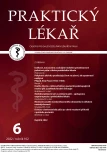Homenursing care after a strokefrom the perspectiveofpatients
Authors:
S. Bártlová; L. Šedová; A. Hudáčková; F. Dolák; L. Havierniková
Authors‘ workplace:
Ředitelka: prof. PhDr. Valérie Tóthová, Ph. D.
; Jihočeská univerzita v Českých Budějovicích Zdravotně sociální fakulta Ústav ošetřovatelství, porodní asistence a neodkladné péče
Published in:
Prakt. Lék. 2022; 102(6): 311-316
Category:
Of different specialties
Overview
The goal of the study focused on post-stroke patients was to identify whether the patients suffered from sequelae, required the care provided by other persons, and which services they used within the home care.
Methods: The design of the study was quantitative. The field study used the method of a standardized face-to-face interview. The sample consisted of 416 post-stroke patients, 207 (49.8%) men and 209 (50.2%) women.
Results: In the respondents, the most frequent persisting post-stroke problems included disturbed coordination of mobility (57.2%), weakness in or motility loss of upper or lower limbs (47.1%) and speech problems (43.5%). The persisting symptoms significantly correlate with age < 0.001 and occupation < 0.001. 43.0% post-stroke patients said that their condition always or often demanded a care or another person; in some cases, this care was demanded by more than a quarter of respondents. The Home Care Agency services are used by less than ½ of (47.6%) respondents. The utilization of these services significantly correlates with age < 0.001, occupation < 0.001 and the time that has passed since stroke < 0.001. The most frequently used post-stroke services include the services provided by physiotherapists and social workers, the least demanded services are those provided by psychiatrists and psychologists.
Conclusion: Post-stroke patients have particularly to rely on the home care nurses help or the help offered by selected professionals the patients have been informed on. The study showed that this was not sufficient since it did not outreach into the aftercare. Therefore, one of the goals of our project is to develop a program for a lifelong education of nurses taking care of stroke patients, and to propose an increase of competences for nurses in the aftercare of stroke patients.
Keywords:
stroke – home care – physiotherapist – social worker – psychologist – psychiatrist
Sources
1. Booth J, Connelly L, Lawrence M, et al. Evidence of perceived psychosocial stress as a risk factor for stroke in adults: a meta-analysis. BMC Neuro 2015; 15: 233.
2. Cecil R, Thompson K, Parahoo K, McCaughan E. Towards an understanding of the lives of families affected by stroke: a qualitative study of homecarers. J Adv Nurs 2012; 69(8): 1761–1770.
3. Gibbon B, Gibson J, Lightbody CE, et al. Promoting rehabilitation for stroke survivors. Nurs Times 2012; 108(47): 12–15.
4. Hackett ML, Yapa C, Parag V, Anderson CS. Frequency of depression after stroke: a systematic review of observational studies. Stroke 2005; 36(6): 1330–1340.
5. Hekmatpou D, Mohammad Baghban E, Mardanian Dehkordi L. The effect of patient care education on burden of care and quality of life of caregivers of patients with stroke. J Multidiscip Healthc 2019; 12: 211–217.
6. Imhof L, Suter-Riederer S, Kesselring J. Effects of mobility-enhancing nursing intervention in patients with MS and stroke: randomised controlled trial. Int Sch Res Notices 2015; 785497.
7. Kim NH, Tae YS. The development and evaluationofnavigation program forcaregiversofstrokepatientsadmitted to a rehabilitationcenters: a pilot study. Korean J AdultNurs 2018; 30(3).
8. Kronenberg G, Schoner J, Nolte C, et al.Charting the perfectstorm: emergingbiologicalinterfacesbetween stress and stroke. Eur Arch Psychiatry ClinNeurosci 2017; 267: 487–494.
9. Murray J, Ashworth R, Forster A, Young J. Developing a primary care-basedstrokeservice: A reviewof the qualitativeliterature. Br J Gen Pract 2003; 53: 137–142.
10. Pucciarelli G, Ausili D., Galbussera AA, et al. Quality oflife, anxiety, depression and burdenamongstrokecaregivers: A longitudinal, observationalmulticentre study. JAdvNurs 2018; 74(8): 1875–1887.
11. Robinson-Smith G, Harmer C, Sheeran R,BellinoVallo E. Couples’ copingafterstroke-a pilot intervention study. RehabilNurs 2016; 41(4): 218–229.
12. Schlote A, Poppendick U, Möller C, et al. Kenntnis von Unterstützungsangeboten nach erstemSchlaganfall. Rehabilitation 2008; 47(3): 136–144.
13. Vacková J, Bendová M, Švestková O, a kol. Sociální práce v systému koordinované rehabilitace u klientů po získaném poškození mozku (zejména CMP) se zvláštním zřetelem na intervenci z hlediska sociální práce, fyzioterapie, ergpterapie a dalších vybraných profesí. Praha: Grada Publishing 2020.
14. Westergren A, Ohlsson O, Hallberg IR.Eatingdifficulties, complications and nursinginterventionsduring a period ofthreemonthsafter a stroke. J AdvNurs 2021; 35(3): 416–426.
15. Williams L, Ghose SS, Swindle R.Depression and other mental health diagnoses increase mortality risk after ischemic stroke.Am J Psychiatry 2004; 161: 1090–1095.
Labels
General practitioner for children and adolescents General practitioner for adultsArticle was published in
General Practitioner

2022 Issue 6
Most read in this issue
- Homenursing care after a strokefrom the perspectiveofpatients
- Indications, timing and initiation of mobile specialized palliative care and the role of the general practitioner
- The multidisciplinary team in primary care – cooperation between an occupational therapist and a general practitioner
- Quality of life and risk factors of the patients undergoing lung resection from the perspective of thoracic surgery
